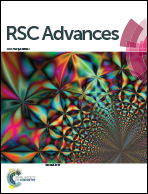Facile preparation of carbon-functionalized ordered magnetic mesoporous silica composites for highly selective enrichment of N-glycans†
Abstract
Highly selective and efficient enrichment of glycans from complex biological samples is of great significance for the discovery and diagnosis of disease via identifying the related biomarkers. Mesoporous carbon materials were widely employed for the selective enrichment of glycans due to the strong interactions between carbon and glycans. In this study, novel carbon-functionalized ordered magnetic mesoporous silica composites (denoted as Fe3O4@3SiO2@mSiO2–C) with a core–shell structure, high carbon content, excellent hydrophilic property and unique magnetic character were designed and synthesized. A strategy involving CTAB as the mesoporous structure-directing agent and the carbon precursor during in situ carbonization was proposed. Besides, a compact silica layer with adequate thickness was essential to protect the magnetic core during the sulphonation process in further high-temperature calcination. As a result, the obtained Fe3O4@3SiO2@mSiO2–C composites exhibited a high carbon content (25%) with graphite structure, rapid magnetic separation (within 10 s), large pore volume (0.257 m3 g−1), high BET surface area (269.14 m2 g−1) and a well-ordered mesostructure (3.39 nm). In addition, a strong magnetic response with a saturation magnetization value (59.8 emu g−1) has been confirmed. By taking the advantage of the special interaction between the carbon and glycans, the size-exclusion ability and highly hydrophilic as well as unique magnetic properties, the Fe3O4@3SiO2@mSiO2–C composites exhibit satisfying enrichment ability in glycomic analysis. Better selectivity and efficiency than active carbon have been confirmed. Furthermore, 42 N-linked glycans with sufficient peak intensities were obtained from human serum after treatment with the Fe3O4@3SiO2@mSiO2–C composites, showing great potential as a tool for the enrichment and detection of glycans in biological samples.


 Please wait while we load your content...
Please wait while we load your content...